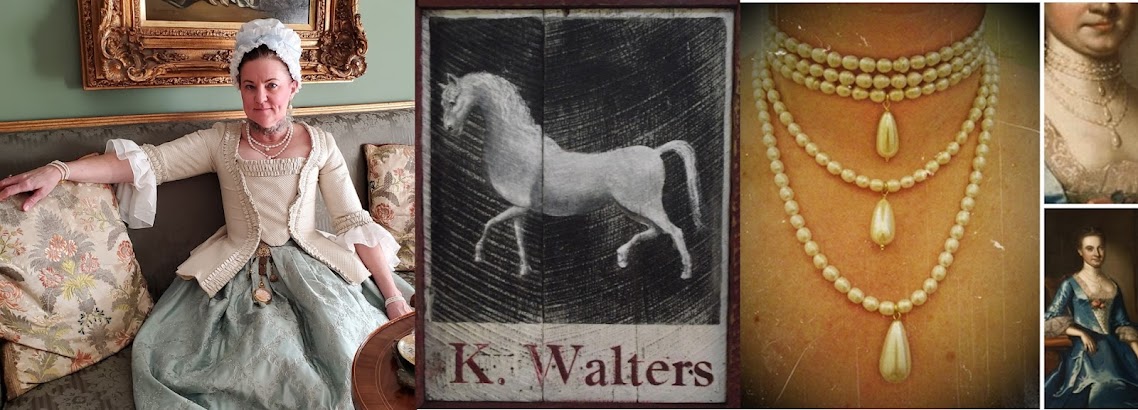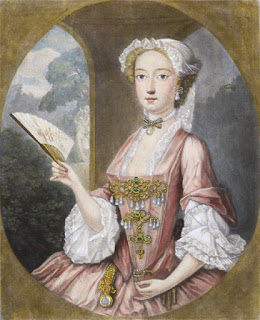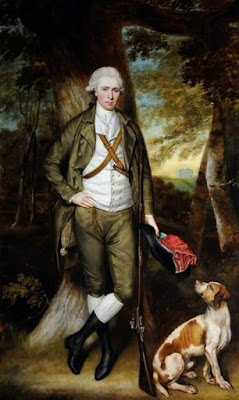Portrait of a lady Margaret Arundel Lady Weston, attributed to Robert Peake the Younger
circa 1610-1616
May 1745, by Thomas Burford
The Personification of May
The "Equipages, Chatelaines, and Macaronis" The Working life of Museum of London article mentions that "An equipage consisted of a hook, which would have been invisible when worn....Attached to this hook were one or several, often highly ornamental, plaques, from which dangled not only watches, but also various trinkets or ‘toys’, such as containers for thimbles, scissors, bodkins and such like (tassels were also popular)..."
"The distinguished scholar and jewellery collector Dame Joan Evans (who donated part of her collection to the Museum) wrote in 1921: ‘Soon after 1770 the Macaronis [highly fashionable young men] introduced a chatelaine of a new kind. Instead of terminating in a hook, it ended in an ornamental medallion, from which hung tassels and charms, while the supporting chains were slightly longer. This must have been held in place by the waistbelt so that the watch and the tassels both hung down. Fobs were also worn, one end hung with a watch and the other with a heavy seal, a dummy watch, or fausse montre’ [fake watch to you and me]."
In the early to mid 1770's, we see ribbon or chain hanging down from one or both sides of a man's breeches that show charms or seals. The watch itself would be in the fob (or pocket). The counterbalance of the charms and seals were a nice decoration and also fashionable. This was also done with women, but it hung from a hook on their petticoats.
During the 1770's and 1780's, the trend shifted to having two watch chains - one with a real watch and the other with a tassle, faux watch, medallion, or whatever they liked or was the trend.
We also see this trend and fashion into the 1790's and going into the new century.
Fashionable Spring Walking Dresses, fashion plate, hand-colored engraving on paper, published by John Bell in La Belle Assemblie, London, June, 1808
Miss Mary Edwards by William Hogarth, 1742, The Frick Collection
William Wollaston, ca. 1759, by Thomas Gainsborough
Galleries des Modes
Galleries des Modes, 1779
Joshua Walker of Clifton House, 1780
1786, December, Magasin des Modes
During the 1770's and 1780's, the trend shifted to having two watch chains - one with a real watch and the other with a tassle, faux watch, medallion, or whatever they liked or was the trend.
Portrait of Captain George Montagu circa 1780-1790
Attributed to Thomas Beach or Franci Abbott
We also see this trend and fashion into the 1790's and going into the new century.
Hugh Douglas Hamilton, R.H.A., Arthur Hill, 2nd Marquess of Downshire 1785-90 pastel
Fashionable Spring Walking Dresses, fashion plate, hand-colored engraving on paper, published by John Bell in La Belle Assemblie, London, June, 1808
Restrained and classic outfit. Costume Parisien, 1816
Jacoba van Wessem by Dirk van Oosterhoudt, ca. 1820-1830
An excellent source of information, and to see originals, can be found on the 18th Century Notebook under 18th Century Chatelaines and Equipage or at the 18th Century Material Culture Resource Center's
Time Pieces and Watch Chains
Time Pieces and Watch Chains













